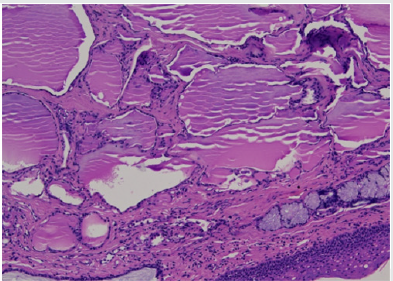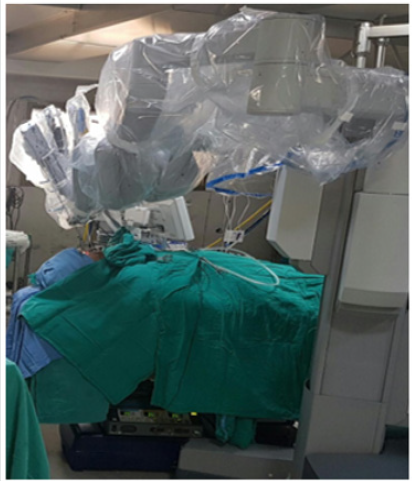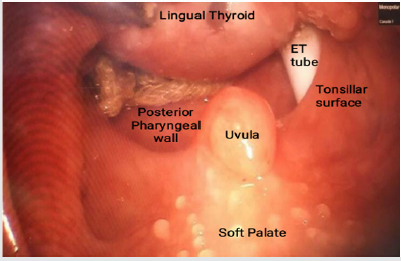Lupine Publishers | Journal of Otolaryngology
Introduction
Surgical removal of ectopic lingual thyroid is indicated in symptomatic patients or in cases of suspected malignancies. An external approach is most often used but is associated with morbidity and visible scar on cervical region. In this case we utilized Transoral Robotic surgery [TORS] to excise ectopic lingual thyroid tissue. Ectopic thyroid refers to the presence of thyroid tissue in locations other than the normal anterior neck region between the second and fourth tracheal cartilages. It is the most frequent form of thyroid dysgenesis, accounting for 48-61% of the cases [1]. Lingual thyroid is a rare developmental anomaly originating from aberrant embryogenesis during the passage of the thyroid gland through the neck. Prevalence of this condition is reported to be between 1 per 100,000-300,000 persons and occur one in 4,000- 8,000 patients with thyroid disease [2]. To date, about 500 cases have been reported in the English literature mainly from Europe, Asia and America, with a small number of reports coming from Africa. Sixty-five to eighty percent of cases occurred in females [2]. Although it is difficult to detect asymptomatic thyroid ectopy, postmortem studies have suggested that 7-10% of adults may harbor asymptomatic thyroid tissue along the path of the thyroglossal duct [3]. In 1869, Hickman reported the first case of ectopic thyroid tumour of the base of the tongue, pressing down the epiglottis on the larynx and causing death by suffocation sixteen hours after birth [4]. In 1999, da-Vinci robot was developed by intuitive company in USA. It contains high magnification 3-D endoscope, endo-wristed instruments with motion scaling and tremor filtration function that help surgeons to perform endoscopic surgery with more precision, dexterity and control. conventional transoral approach has the disadvantages of limited exposure and difficulty in manipulation and hemostasis [5]. In this paper we report a case of 16 years old lady from Nepal who presented to our hospital with choking symptoms which are more during night since years. She was treated as an asthmatic and had no improvement with bronchodilators. She was referred to our center for further evaluation to rule out any ENT cause. Fiberoptic laryngoscopy lead to provisional diagnosis of lingual thyroid. She underwent excision of ectopic thyroid tissue by Da Vinci robotic surgical system. Histopathological examination confirmed lingual thyroid (Figure 1).
Figure 1: Photomicrograph of histology section, Hematoxylin Eosin stain, 10 X magnification, showing covering of normal squamous epithelium of tongue, with many variable sized colloids filled thyroid follicles in the subepethelium.

Case Report
A 16-year-old female presented with dyspnoea especially at night and foreign body sensation throat. The patient also had complaints of dysphagia. She had no history of either past or present thyroid disease. Upon examination, the patient presented a solid, pink, spherical mass, covered with intact mucosa, located at the base of the tongue. Examination of the neck revealed no palpable thyroid gland in the normal pre-tracheal position and no cervical adenopathy. Thyroid hormone tests showed normal thyroid-stimulating hormone (TSH) concentrations and normal FT3 and FT4 concentrations. Patient was clinically euthyroid. Ultrasonography (US) revealed a mass 5x4cm in size with distinct margins restricted to the base of the tongue and absence of the thyroid gland. A thyroid scan with technetium Tc-99m sodium was performed showing marked isotope uptake in the area of the tongue and no uptake in the neck (Figure 2).
Figure 2: Photomicrograph of histology section, H & E stain, 20 X, with similar features as in slide 1.

Method
Patient was taken up for transoral robotic surgical excision of
lingual thyroid tissue under
general anesthesia. The da Vinci Si surgical system (Intuitive
Surgical, Sunnyvale, CA) used.
a) Patient position is like Rose’s position of tonsillectomy.
Neck is extended by sandbag under the shoulders and the head
is supported on a ring.
b) Painting & draping done.
c) Docking of the robot done. Mass base of tongue visualized
using 30 degree up endoscope. 4mm instruments used for
dissection.
d) Maryland dissector at left hand side and spatula tip
electro-cautery at right hand side.
e) Resection carried out from the anterior border of the
lingual thyroid along the capsule
f) of ectopic thyroid tissue. Mass excised in toto. Hemostasis
confirmed.
g) Undocking of robot done. GA withdrawn.
h) Excised tissue sent for histopathological examination.
i) Pt. kept in hospital overnight for observation. No
postoperative complications.
j) Post operatively substitutive thyroid hormone
replacement therapy was given.
Gross description: Multiple mucosa covered tissue pieces altogether measure 5x2x0.5cm. No ulcer or mass lesion is identified on the surface. The cut surface shows a brownish, colloid like appearance.
Microscopic description: Sections show unremarkable stratified squamous epithelial lining. The subepithelial stroma shows islands of normal thyroid follicles and few seromucinous salivary glands, with mild lymphoid cell infiltrate. There is no evidence of malignancy (Figure 3).
Conclusion: Excised swelling base of tongue - LINGUAL THYROID.
Results
TORS of ectopic lingual thyroid tissue was successfully performed with excellent functional outcomes and with decreased operating time than conventional tongue base surgeries. Less than 5 ml blood loss during surgery and stay in the hospital was less than 24 hours (Figure 4).
Discussion
Lingual thyroid is reported to be a rare congenital anomaly
in the population. Asymptomatic ectopic thyroid tissue becomes
symptomatic in periods of puberty, pregnancy, menopause,
inflammation, and stress. Thyroid requirement increasing in these
periods leads TSH level to increase and hypertrophy in the thyroid
gland [8]. Approach to lingual thyroid tissue may vary according
to clinical findings, but it is still debatable. Although asymptomatic
cases can be followed without management for probable
complications, in symptomatic cases, there are alternative treatment
methods. Even though thyroid suppressive treatment conducted
with the administration of exogenous thyroid hormone is a method
that can be preferred in patients with minimal symptoms, it is
not preferred in that it requires long term treatment. Radioactive
iodine treatment and surgery are other treatment alternatives. As
it is in a region difficult to access, open surgical approaches have
been used in surgical treatment [9]. These surgical approaches
may lead morbidity rates to increase according to the method
used since they require lip, tongue, and mandibular splitting or
lateral, suprahyoid pharyngotomy and long operation times and
feeding with nasogastric tube, they run the risk of the development
of suprahyoid pharyngotomy, hospitalization is prolonged, and
there are skin scars. In order to avoid these morbidities, transoral
resection techniques including Co2 laser, electrocautery, and
harmonic technologies are used.
Terris et al. [10] reported that transoral minimal invasive
lingual thyroid resection decreased morbidity and duration of
hospitalization compared to other open approaches. Coblation
assisted lingual thyroid and lingual tonsil resection techniques
were used and successful results were reported [11-13]. Leitzbach
et al. [12] reported successful results and low complication rates in
108 patients undergoing coblation assisted resection due to tongue
root and lingual tonsil hypertrophy. However, transoral resection
techniques have limited point of view and lead to difficulty in
resection owing to difficulty in manipulation, which restricts
their use [6]. Studies have demonstrated that as the size of the
mass increases, transoral respectability of the mass decreases.
The basic principles of avoiding complications in transoral tongue
root resections are careful dissection in accordance with imaging
methods and adequate anatomic evaluation in order to prevent
lingual artery injury [14]. Transoral robotic surgery decreases the
technical difficulties encountered in other transoral approaches
in that it has a three-dimensional larger point of view, and
manipulation is easier thanks to robotic instruments, leading to
its larger use in oropharyngeal and tongue root operations [7].
Transoral robotic surgery is used in many different regions in
surgical otolaryngology [15,16]. Three robotic arms, 0-degree and
30-degree high definition and 3-dimensional video instruments
make it possible to overcome restriction of visualization of regions
with difficult access and difficulty of manipulation. Lingual thyroid
excision using this method has been described in previous studies
[17,18]. The absolute local contraindication is related to the difficult
exposition of the oropharynx, due to a limited opening of the mouth
or the patient’s habitus. TORS for treatment of ectopic lingual goiter
is feasible, requires a short learning curve, and appears to be safe
[19]. In addition, the robotic surgery also has been adopted to do
esthetic neck surgery with better cosmetic outcomes by hiding the
scar [20].
Conclusion
TORS assisted excision of ectopic lingual thyroid is minimally invasive, feasible method. It is a safe technique with minimum morbidity and decreased operative time. In experienced hands it should be offered as valid treatment for this pathology. Studies with larger case series and longer duration of follow-up are required in order to reach a definitive conclusion on this issue.
Read More Lupine Publishers Otolaryngology
Journal
Articles:
https://lupine-publishers-otolaryngology.blogspot.com/



No comments:
Post a Comment